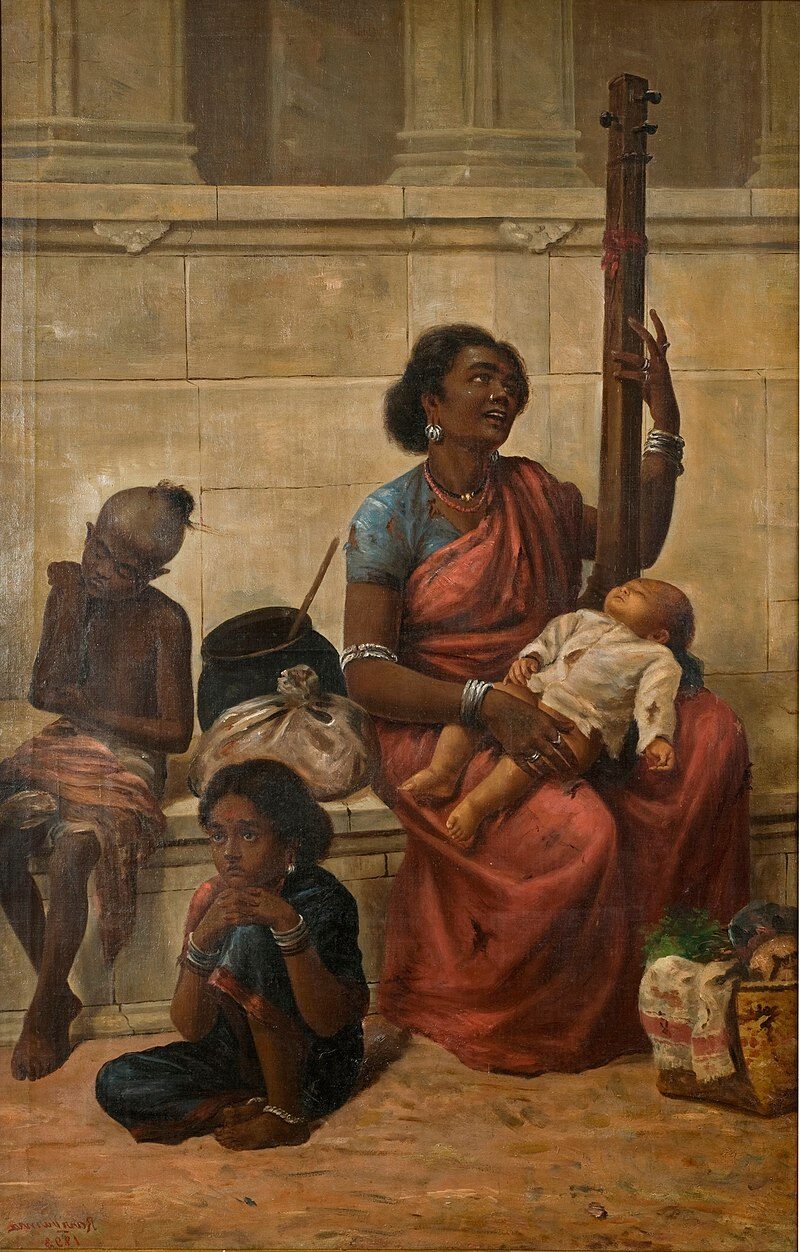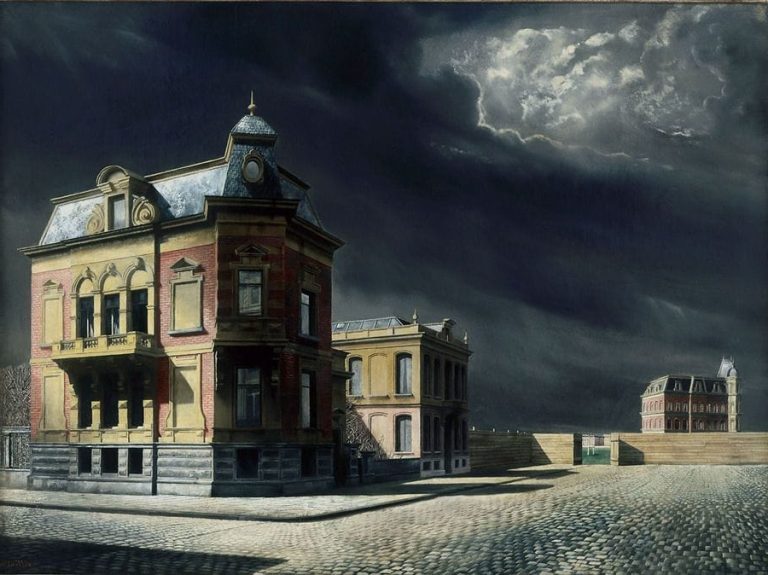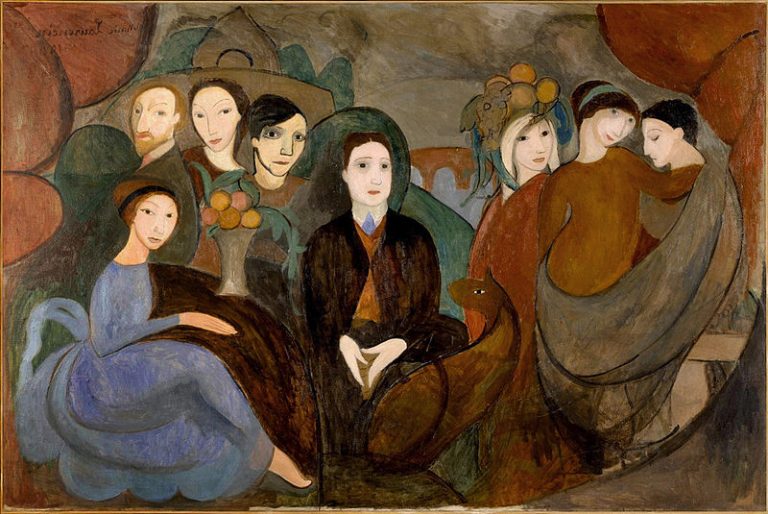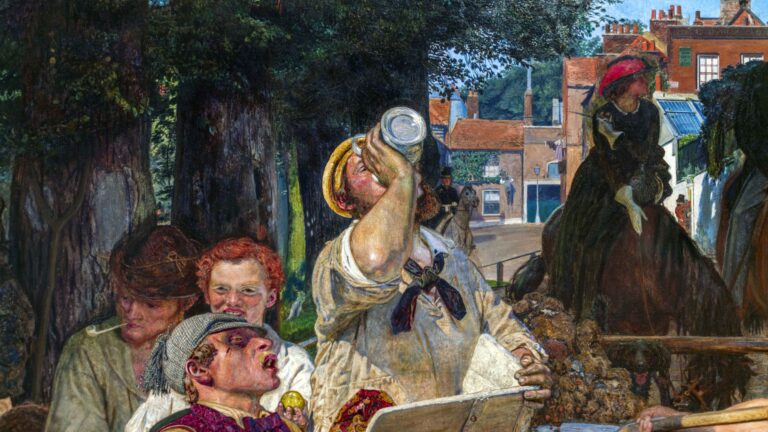Raja Ravi Varma Paintings: A Glimpse into Indian Art Mastery
Born: 29 April 1848, Thiruvananthapuram, India
Death: 2 October 1906, Attingal, India
Art Movement: Academic Art
Nationality: Indian
Influenced By: Rama Swami Naidu and Theodor Jenson
Institution: Sir J. J. Institute of Applied Art, Mumbai
Raja Ravi Varma Paintings: A Glimpse into Indian Art Mastery
Raja Ravi Varma: The Artist and His Legacy
Raja Ravi Varma is a celebrated figure in Indian art. He is known for pioneering the fusion of European academic art with Indian themes. His works brought mythological and cultural stories to life, making them accessible and admired by many.
Early Life and Artistic Beginnings
Raja Ravi Varma was born in 1848 in Kilimanoor, a small town in the princely state of Travancore. He showed artistic promise from an early age. His uncle realized his talent and supported him by providing materials and instruction. As he grew, he spent time learning from local temple artists. Later, he received guidance from trained painters.

Shakuntala Patra-lekhan (1876) by Raja Ravi Varma
This mix of local and formal education laid the foundation for his unique art style. His early exposure to traditional Indian art forms and his later training in oil painting techniques set the stage for his innovative work, bridging traditional Indian art with more contemporary methods.
Impact on Indian Art and Aesthetic
Raja Ravi Varma’s art played a critical role in shaping modern Indian aesthetics. By depicting scenes from the Ramayana and Mahabharata, he spread cultural awareness and national pride. His paintings became household names, making divine and mythological stories accessible to all.
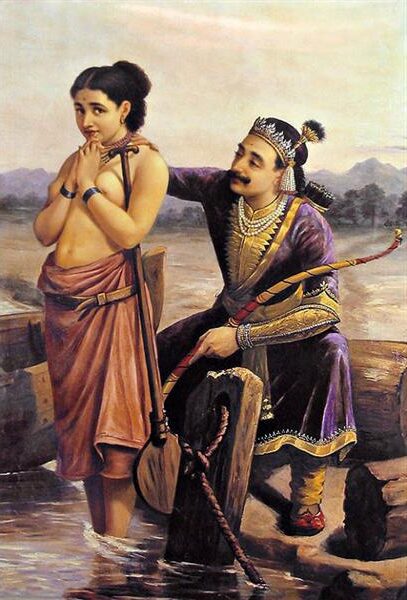
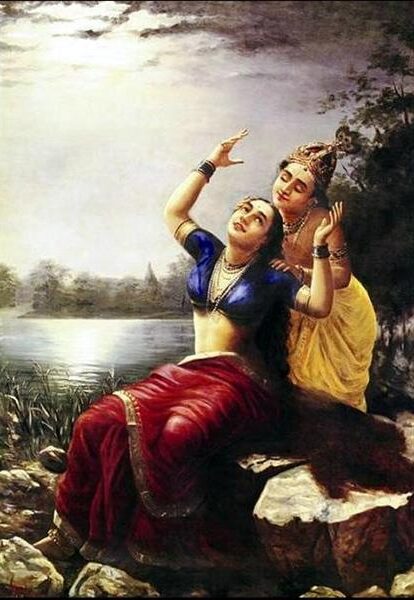
He also introduced the printing of lithographs, which allowed his art to reach a wider audience. This democratization of art, previously only available to the elite, changed how people viewed and valued artwork in India. His work remains influential in contemporary culture, inspiring artists and filmmakers even today.
Influence of European Techniques and Indian Sensibility
Varma skillfully combined European painting techniques with Indian subjects, creating a style that resonated with many. Learning from European methods of realism, he focused on perspective and depth, enriching his Indian-themed paintings. The blend of Indian motifs with precision in anatomy and detailing marked his signature style.
This fusion attracted patrons from across India who appreciated not only the cultural themes but also the quality and sophistication in his work. By integrating these elements, Varma established a new narrative in art that celebrated Indian history while embracing global techniques, ensuring his legacy continues to impact art.
Iconic Paintings and Their Cultural Significance
Raja Ravi Varma’s paintings are renowned for their intricate depictions of Hindu deities and mythological stories, portraits of Indian women and nobility, as well as famous works with captivating backstories. These elements highlight the intersection of art and culture in his oeuvre.
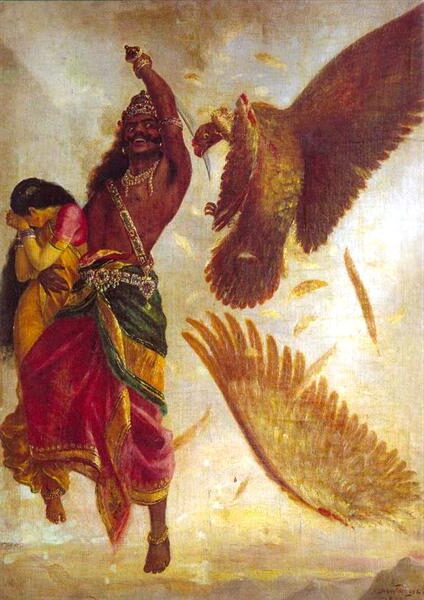
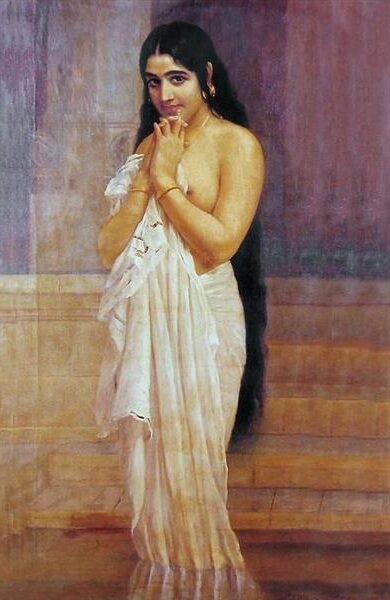
Depictions of Hindu Deities and Mythology
Ravi Varma’s paintings vividly capture stories from Indian epics and Puranas. His work often features Hindu deities like Krishna in Sri Krishna as Envoy and scenes from the Mahabharata.
His portrayal of Shakuntala, a character from ancient texts, is celebrated for its emotional depth. These paintings not only showcase the deities but also reflect the cultural stories they embody.
Portrayals of Indian Women and Aristocracy
His portraits of Indian women, like Damayanti and Woman Holding a Fruit, display grace and dignity. Ravi Varma skillfully captured their elegance and attire, depicting them as central figures.
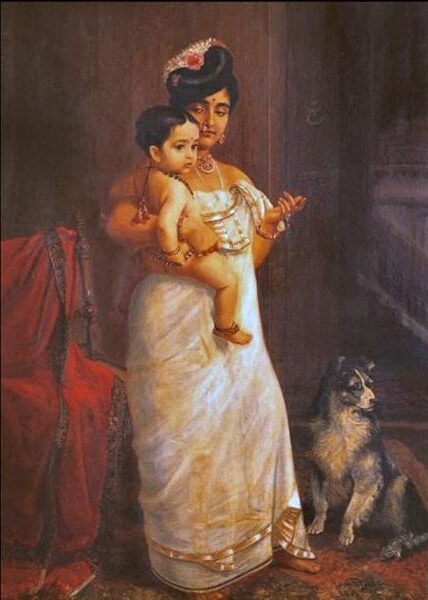
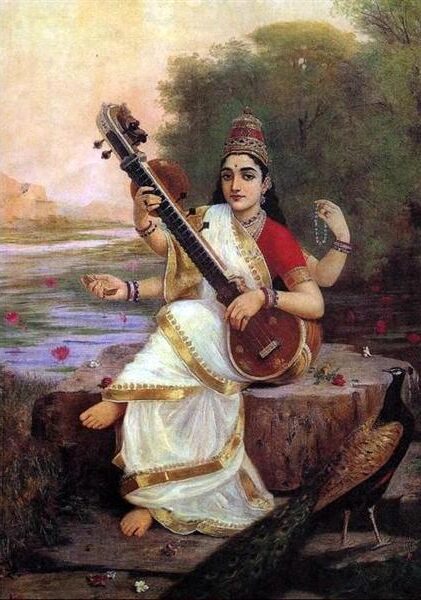
There Comes Papa is notable for its portrayal of his daughter, Mahaprabha, symbolizing familial bonds. His ability to blend traditional themes with a modern gaze is evident in these depictions.
Notable Works and Their Stories
More than just paintings, Ravi Varma’s works tell rich stories. Galaxy of Musicians captures the diversity of India through the portrayal of various musicians.
Another iconic painting, Stolen Interview, reflects intriguing narrative elements. His artwork seamlessly combines narrative and visual beauty, making them timeless pieces that continue to captivate viewers today.
Technique, Style, and Mediums
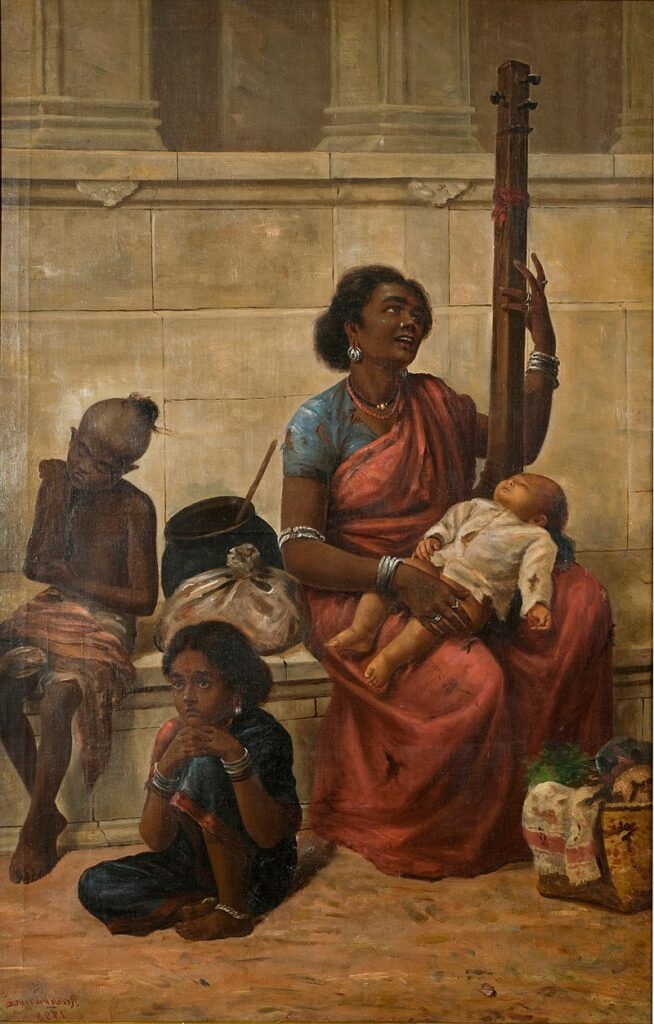
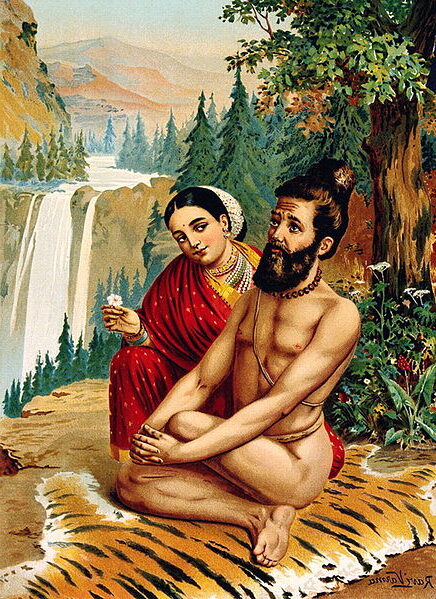
Raja Ravi Varma masterfully combined Western art techniques with Indian cultural themes, revolutionizing Indian art. His use of oil painting on canvas brought a new dimension to his work, while his innovative lithographs and oleographs made art accessible to many.
Adoption of Oil Painting
Raja Ravi Varma was among the first Indian artists to adopt oil painting, a technique introduced to him through European influences. This medium allowed him to create realistic textures and depth, bringing his subjects to life with a vividness previously unseen in Indian art.
Oil painting on canvas enabled Varma to incorporate intricate details, such as the expressions on faces and the various textures of fabrics, which imbued his portraits and mythological narratives with a striking realism. This was a departure from the traditional Indian art forms prevalent at that time, marking a significant transformation in the Indian artistic landscape.
Integration of Indian Themes
While Raja Ravi Varma embraced Western painting techniques, he stayed rooted in Indian culture by integrating themes from Indian mythology and history. He drew inspiration from Sanskrit epics, Kathakali dance dramas, and traditional Indian life.
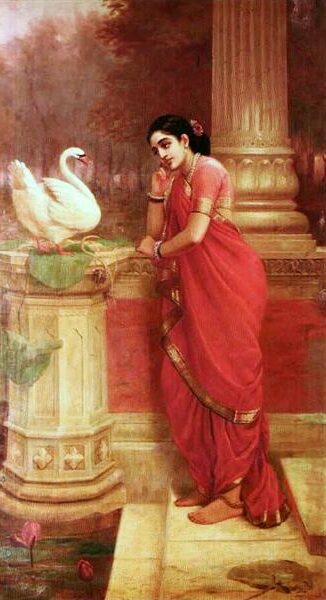
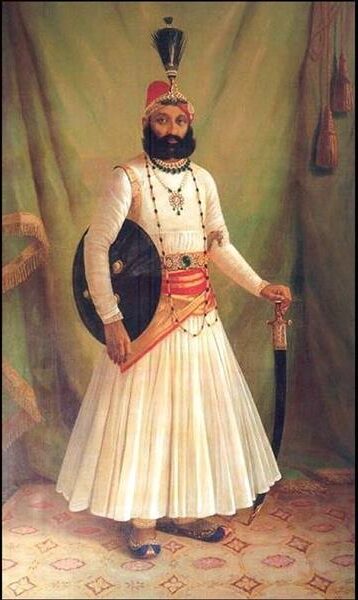
Characters from the Mahabharata and Ramayana became central figures in his paintings, bridging a gap between Western technique and Indian storytelling. Varma’s ability to blend these elements set his work apart, making it culturally resonant and widely celebrated.
Development of Lithographs and Oleographs
Raja Ravi Varma’s foray into lithographs and oleographs transformed the accessibility of art in India. He mastered these printing techniques, which allowed for the mass production of his artwork.
Varma’s chromolithographs and subsequent oleographs depicted Indian deities and scenes from mythology in rich color and detail. This advancement democratized art in India, allowing people of various social and economic backgrounds to have access to high-quality images of artistic and spiritual significance.
Preservation and Display of Artworks
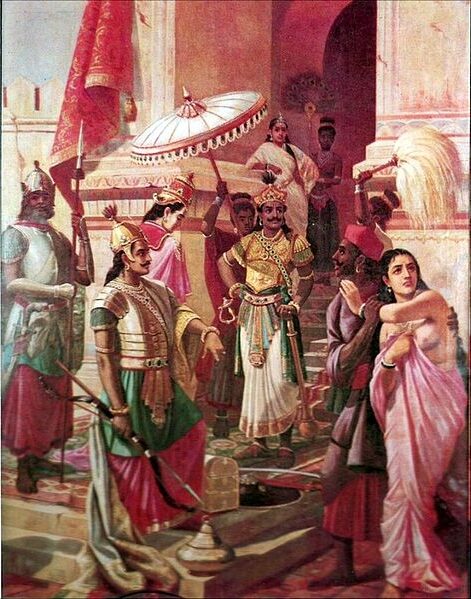
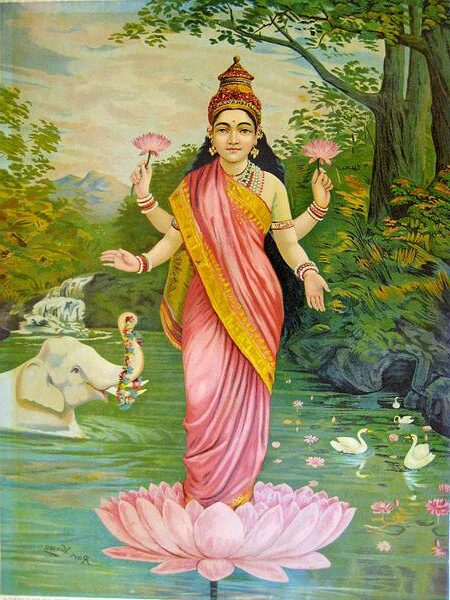
Raja Ravi Varma’s paintings hold a significant place in Indian art history. Preserving these masterpieces and displaying them appropriately is crucial in ensuring they remain accessible to enthusiasts and scholars alike.
Art Galleries and Museums
Raja Ravi Varma’s artworks are prominently featured in several prestigious galleries and museums across India. The Raja Ravi Varma Art Gallery in Kerala boasts a collection of his original paintings. This gallery carefully preserves these artworks, ensuring they are properly maintained for future generations.
In Chennai, the Government Museum houses a number of his works, displayed to highlight his contribution to Indian modern art.
The National Gallery of Modern Art also presents some of his pieces, emphasizing both preservation and the educational value of Varma’s works in Indian art history. Attention to proper climate and lighting conditions helps protect these unique artifacts, allowing visitors to appreciate their original splendor.
Legacy in Modern Art Spaces
Raja Ravi Varma’s legacy extends to modern art spaces, influencing contemporary Indian artists. These influences can be observed in places like the Sri Chitra Art Gallery in Kerala, which celebrates his impact by displaying not only his paintings but also works from other artists inspired by him.
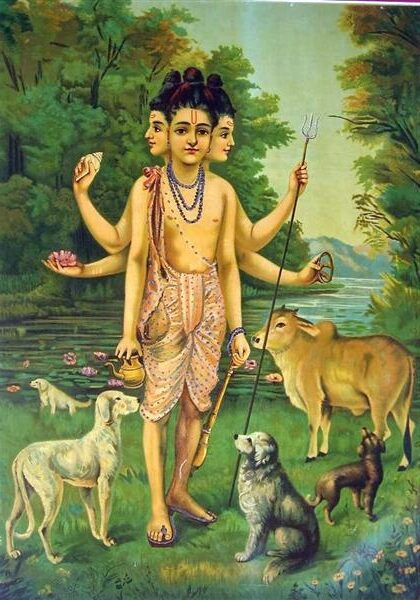

Baroda’s art circles further explore this legacy, showcasing exhibitions that highlight Varma’s style and its relevance to Indian modern art. By incorporating Varma’s artistic techniques, these exhibitions foster a deeper understanding of his influence on today’s art scene.
Such efforts ensure that Varma’s contributions are continually recognized, respected, and integrated into evolving art narratives.
Frequently Asked Questions
Raja Ravi Varma, an iconic Indian artist, is known for merging European styles with traditional Indian themes. His artworks feature mythological figures and stories brought to life with vibrant colors and details.
What are some of the most iconic paintings by Raja Ravi Varma?
Some of the most renowned paintings include “Shakuntala,” “Damayanti Talking to a Swan,” and “The Maharana of Udaipur.” These works capture scenes from Indian mythology and literature with elegance and detail.
How can one identify an original Raja Ravi Varma painting?
Original paintings typically feature Varma’s distinct style, combining Indian themes with European techniques. Authentic works may also be part of verified collections or galleries.
What themes are prevalent in Raja Ravi Varma’s artwork?
His paintings often depict characters and scenes from Indian mythology and epics. He emphasized beauty and drama, presenting divine and royal figures in realistic and accessible ways.
Where can one view Raja Ravi Varma’s paintings in person?
His paintings can be seen in several Indian art galleries, including the Raja Ravi Varma Art Gallery. Many of his works are displayed in art museums across India and occasionally part of international exhibitions.
What techniques did Raja Ravi Varma employ in his painting process?
Varma was known for using oil paints to create a realistic texture and depth. He mastered European techniques to enhance the vividness and detail of Indian themes in his paintings.
How has Raja Ravi Varma influenced modern Indian art?
Raja Ravi Varma has had a lasting impact on Indian art. He inspired countless artists. He helped to popularize Indian mythology through visual media. Varma also set a precedent for combining Western art techniques with Indian subject matter.



